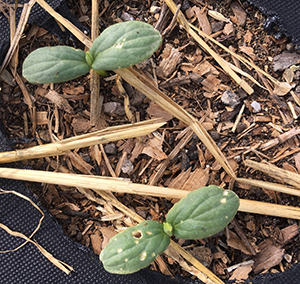Flea Beetles Detection and Management
by Zac Hoppenstedt
Return to Insect Agent Articles
 Due to cool spring weather this season, pest pressure in the veggie garden has been mostly negligible. However, the inquiries at our office are steadily rising with a similar issue. “What are these small holes or bites on my broccoli leaves, my salad greens, my cucumber seedlings?”
Due to cool spring weather this season, pest pressure in the veggie garden has been mostly negligible. However, the inquiries at our office are steadily rising with a similar issue. “What are these small holes or bites on my broccoli leaves, my salad greens, my cucumber seedlings?”
This time of year, the answer is usually flea beetle feeding damage. These are one of the earliest spring pests that the vegetable grower will encounter.
Flea beetles are small, black and very elusive — you never seem to see them, only the damage that they do. You would think with all the little holes you would see one now or then.
What are flea beetles?
Although, taxonomically unrelated, flea beetles are a group of small leaf beetles with an ability to jump when disturbed like the common flea. There are several different species that make up this pest family and they collectively feed on numerous plant types including lettuce, cabbages, corn, nightshades, and melons to name a few. And although their grazing marks (small, irregular 1/8” holes on leaves) are quite noticeable, the beetles themselves are extremely hard to detect. This insect group can be black, bronze, brown and some species even have stripes.
If you you want to be 100 percent sure of the predator that you’re up against in the garden, there are a few tricks for “trap scouting” these elusive pests. Some gardeners will bury a bowl beneath the leaves of the crop filled with water and a drop of soap to catch the beetles as they drop from the plant. You can also purchase yellow stick traps to lay under plants.
When you catch a specimen, take it to your local Cooperative Extension Service. Here in Johnson County you can take a picture and email it to our Extension Master Gardener Garden Hotline for help with species ID.
Flea beetle controls
Luckily flea beetles are fairly easy to manage with both cultural and chemical controls. Keeping the garden free of weed and plant debris is the best defense.
However, some gardeners choose to plant a trap crop like densely planted radish to lure the beetles away from other plantings and then spray the trap crop with a insecticide. There are many insecticides labeled for flea beetle damage but you will need to re-apply after watering or a rain.
Generally, plants started from seed are most vulnerable to flea beetle damage. Chemical controls are typically only recommended when foliage shows more than thirty percent damage. By the time we get closer to summer, the plants in the garden will have more true leave and be more resilient to the beetle damage. Likewise, the adult populations will decrease throughout the summer.

Have questions? The Garden Hotline is staffed by trained EMG volunteers and Extension staff who will assist you with questions.
Phone: (913) 715-7050
Email: garden.help@jocogov.org